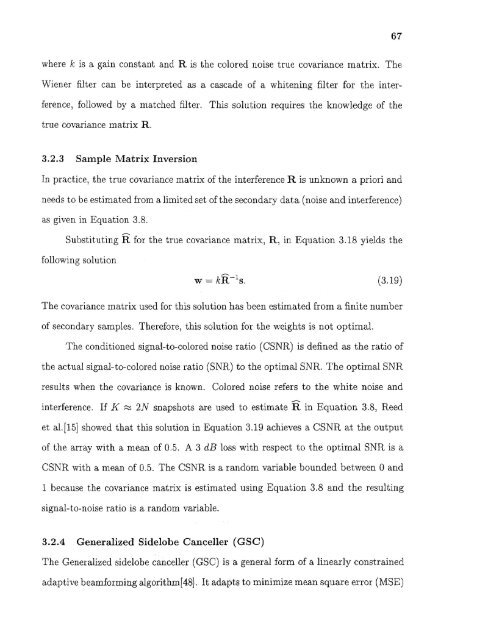Space/time/frequency methods in adaptive radar - New Jersey ...
Space/time/frequency methods in adaptive radar - New Jersey ...
Space/time/frequency methods in adaptive radar - New Jersey ...
You also want an ePaper? Increase the reach of your titles
YUMPU automatically turns print PDFs into web optimized ePapers that Google loves.
67where k is a ga<strong>in</strong> constant and R is the colored noise true covariance matrix. TheWiener filter can be <strong>in</strong>terpreted as a cascade of a whiten<strong>in</strong>g filter for the <strong>in</strong>terference,followed by a matched filter. This solution requires the knowledge of thetrue covariance matrix R.3.2.3 Sample Matrix InversionIn practice, the true covariance matrix of the <strong>in</strong>terference R is unknown a priori andneeds to be estimated from a limited set of the secondary data (noise and <strong>in</strong>terference)as given <strong>in</strong> Equation 3.8.Substitut<strong>in</strong>g R for the true covariance matrix, R, <strong>in</strong> Equation 3.18 yields thefollow<strong>in</strong>g solutionThe covariance matrix used for this solution has been estimated from a f<strong>in</strong>ite numberof secondary samples. Therefore, this solution for the weights is not optimal.The conditioned signal-to-colored noise ratio (CSNR) is def<strong>in</strong>ed as the ratio ofthe actual signal-to-colored noise ratio (SNR) to the optimal SNR. The optimal SNRresults when the covariance is known. Colored noise refers to the white noise and<strong>in</strong>terference. If K 2N snapshots are used to estimate R <strong>in</strong> Equation 3.8, Reedet al.[15] showed that this solution <strong>in</strong> Equation 3.19 achieves a CSNR at the outputof the array with a mean of 0.5. A 3 dB loss with respect to the optimal SNR is aCSNR with a mean of 0.5. The CSNR is a random variable bounded between 0 and1 because the covariance matrix is estimated us<strong>in</strong>g Equation 3.8 and the result<strong>in</strong>gsignal-to-noise ratio is a random variable.3.2.4 Generalized Sidelobe Canceller (GSC)The Generalized sidelobe canceller (GSC) is a general form of a l<strong>in</strong>early constra<strong>in</strong>ed<strong>adaptive</strong> beamform<strong>in</strong>g algorithm[48]. It adapts to m<strong>in</strong>imize mean square error (MSE)
















